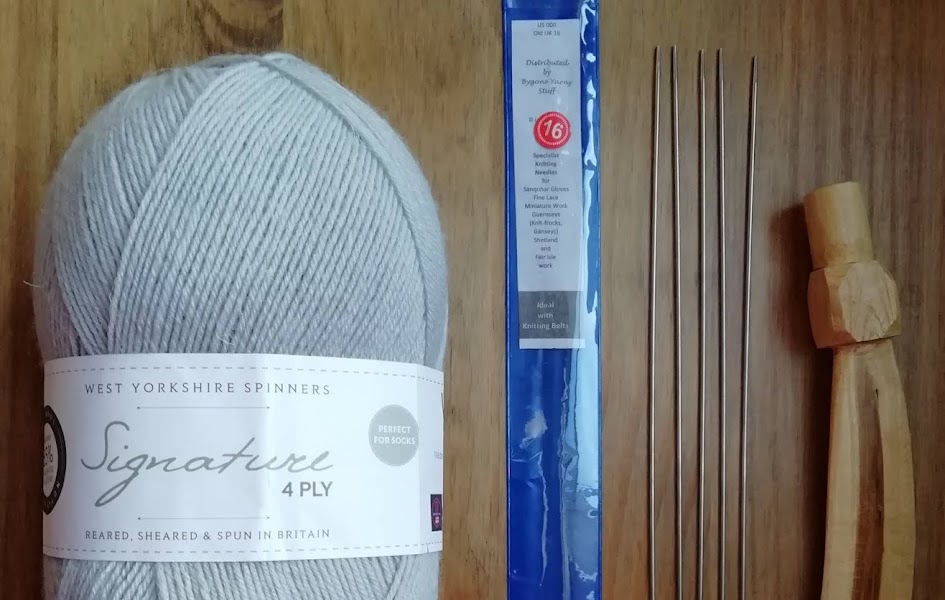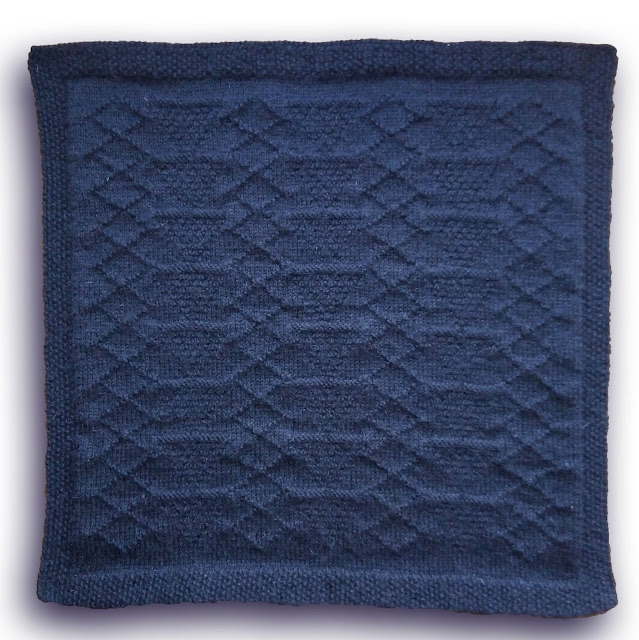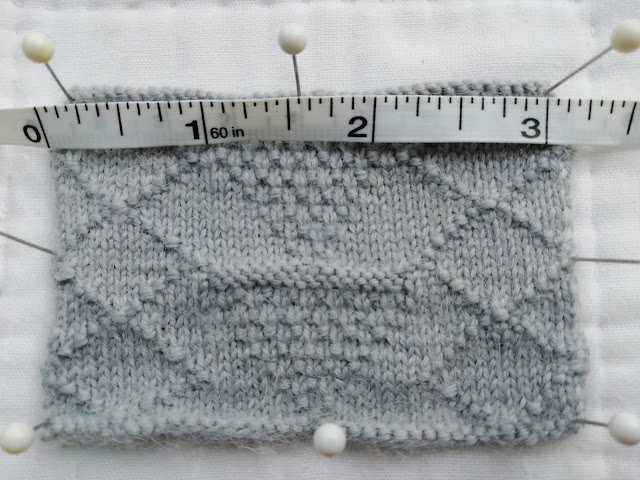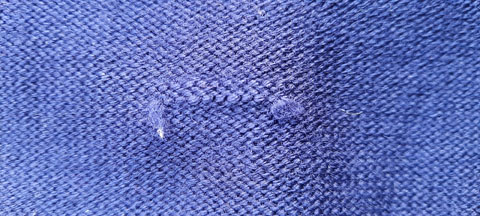Yarn and needles for ganseys
Knitting up the old patterns
 One of the Northfolk sub-projects is to work with Sheringham Museum Textile Group to record the patterns from local fishermen's ganseys. The number of different patterns I have charted has grown nicely. I have tried to encourage the knitters in the group (I am not a knitter) to up their game and emulate the old Sheringham knitters, to knit on smaller needles with finer yarn. We can't get hold of the same 3-ply worsted they used of old but for the time being we are using sock wool (Signature 4-ply from West Yorkshire Spinners) for test swatches and Frangipani 5-ply worsted for samplers and ganseys. The Signature is worsted with 25% nylon and it has very good stitch definition and in pale grey it is excellent for photography. Unfortunately they don't do a navy so for real ganseys the Frangipani is preferred.
One of the Northfolk sub-projects is to work with Sheringham Museum Textile Group to record the patterns from local fishermen's ganseys. The number of different patterns I have charted has grown nicely. I have tried to encourage the knitters in the group (I am not a knitter) to up their game and emulate the old Sheringham knitters, to knit on smaller needles with finer yarn. We can't get hold of the same 3-ply worsted they used of old but for the time being we are using sock wool (Signature 4-ply from West Yorkshire Spinners) for test swatches and Frangipani 5-ply worsted for samplers and ganseys. The Signature is worsted with 25% nylon and it has very good stitch definition and in pale grey it is excellent for photography. Unfortunately they don't do a navy so for real ganseys the Frangipani is preferred.
Needles and knitting sticks
The preferred needle size to knit Sheringham ganseys has come down from the recommended 2.5 or 2.25 mm to 2 mm and old 16 gauge (about 1.6 mm). Using 5-ply Frangipani with 2 mm needles has an immediate effect of tightening the fabric of the knitting, improving the clarity of the stitches in the pattern but without becoming too stiff or losing its 'drape'. For a stitch count of up to 9 to the inch it's not bad. But to get down to the 12 stitches per inch characteristic of the best Sheringham ganseys you really need size 16s with finer yarn and the results are a joy to behold. I am really hoping that one day we can source some good 3-ply or 4-ply worsted yarn.
The other angle to help increase the quality of the gansey knitting is to use a knitting stick (or a belt) also known as a shield in north Norfolk. This is what the professional knitters and old Sheringham knitters used because it helped them knit more quickly and to create a tight and even fabric. It also enables the knitter to knit for longer with less strain on joints and muscles. I've made seven wooden knitting 'shields' for the group so far, based on home-made designs in museum collections. They have been adopted with varying degrees of enthusiasm ranging from some ladies not being able to get on with the shield at all to a few taking to it after a good deal of practice. It is a matter of re-learning the skills of a lifetime but I believe the initial investment will be repaid in the long run resulting in exquisite output and a happier knitter. After all, the old knitters who depended on their skill and speed for a living used knitting sticks so there must be something in it. Here's the link about knitting shields.
Many modern knitters have adopted the circular needle for knitting in the round. Val Smith, who knits most of the swatches now, prefers to stick to the traditional tools - double pointed needles used with a 'shield' (knitting sheath, knitting stick) or the Scottish padded leather knitting belt (called a makkin or makin' belt). Now that she has mastered the use of the shield she prefers it to the way she used to knit.


Observations on the yarn of old ganseys
By looking at ganseys in museum collections we find there was a great variety of yarn employed for knitting ganseys in the past. They were all worsted spun but different weights, colours and textures. We must of course recognise that after decades of wear the ganseys are a lot thinner than when newly knitted. On the whole however, indigenous Norfolk ganseys were relatively fine in comparison with the rest of the East Coast and particularly fine in Sheringham. Work is still ongoing to look at the nature of these old yarns but rather than the 5-ply worsted used in Yorkshire, Cornwall and elsewhere (e.g. Poppleton's 0½ 5-ply worsted), those used in Norfolk were 4-ply and 3-ply and a little softer. Michael Harvey (in Gladys Thompson p. 85) mentions that Esther Nurse used Paton's Beehive 3-ply worsted in 1950.
Lennie 'Teapot' West was a very traditional Sheringham fishermen and he would not wear thick ganseys. When I visited his home in the early 1980s his wife Ann was using Paton's Nylox 80% wool 20% nylon to knit his ganseys, as this was all she could obtain that was fine enough.
 One gansey I looked at, GP90, was small, only a 35 inch chest and it weighed only 577 g. It was a gansey of amazing quality but it was made from 13 lengths of yarn. The ends were neatly woven in on the inside but some of the ends are very close together, so she must have been using up some small balls of wool. She was certainly being very economical.
One gansey I looked at, GP90, was small, only a 35 inch chest and it weighed only 577 g. It was a gansey of amazing quality but it was made from 13 lengths of yarn. The ends were neatly woven in on the inside but some of the ends are very close together, so she must have been using up some small balls of wool. She was certainly being very economical.
Water repellant qualities
An often repeated phrase in articles about ganseys is that they would "turn water". Some people think that the wool must have been oiled to make it water repellant. When I put this point to Emily Codling (née Cooper) she immediately replied "Oh no, it wasn't oily". There may well have been oiled yarns but Norfolk knitters didn't use it for ganseys. When closely knitted the woollen fabric is naturally water repellant - but not waterproof. I put this to the test but pouring a small puddle of water onto a swatch of finely knitted worsted and watched what happened. For almost a quarter of an hour the small pool of water stood proud, sitting on top of the fabric without wetting it. Then over about 5 minutes it gradually began to wet the wool and soaked until at around 20 minutes it sank in rapidly and wetted the paper towel I had placed below. Without oil the wool fibres have natural hydrophobic properties. Wool is still a good insulator even when it is wet so it is an ideal material to wear at sea.
Reference
Thompson, Gladys. Patterns for Guernseys, Jerseys and Arans. 3rd Edition, 1979. Dover Publications, New York